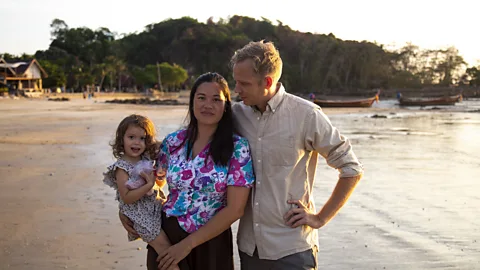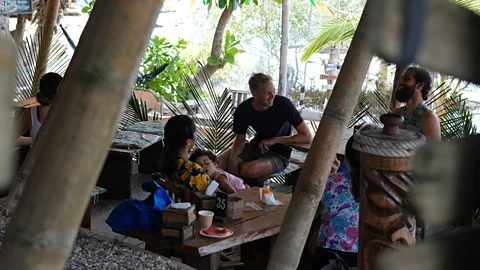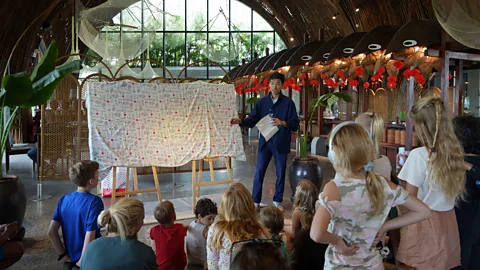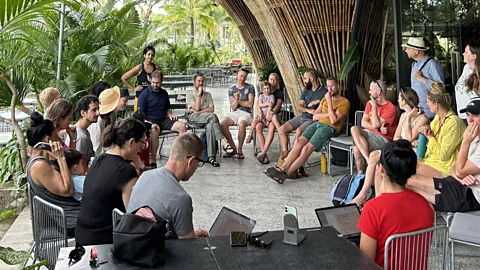A solution for working parents who want to travel
7 min read9 May 2024
By Robyn Huang,
 Laerke Thorndal
Laerke ThorndalThe Travelling Village is an ambitious new experiment uniting 19 digital nomad families for a four-month co-living and co-travelling journey across the world.
Before becoming parents, Danish entrepreneurs Nikolaj Astrup and his wife Michelle Rødgaard-Jessen spent six years as self-employed digital nomads, living and working in China, France, Spain, Nepal and Argentina, among other locations. Naturally, they envisioned a roaming life even after having children. However, their first six-month trip to France and Mexico as a family revealed the challenges of building social connections and support structures on the road with two young children.
“It is quite normal to think you are alone in your nuclear family when you have kids. But it never felt natural to live by ourselves,” explains Astrup of their first travels as a family.
To tackle this desire for community, Astrup and Rødgaard-Jessen, along with three other founding families, launched an experiment: The Travelling Village, which provides digital nomad families with a unique opportunity to share experiences across three locations in Asia.
The project is designed to support working parents by offering co-housing arrangements, communal activities, work groups and shared childcare. It addresses the loss of a traditional support network that digital nomads face by fostering a community and establishing routines through five-week stays in each location, with transition periods for families to decompress.
The experiment, which started on 15 January 2024, has unfolded over four months in Hoi An, Vietnam; Ko Lanta, Thailand; and will end in Kyoto, Japan on 14 May. The 19 families (comprising 70 individuals, including 34 children ranging from one to 14 years old, from Denmark, the US, India, Ireland, Italy and the Netherlands) were selected from 82 diverse applicants. All were united in a desire to raise a family while working and travelling.
 Leheng Sarac
Leheng Sarac“We don’t have a house. We travel, and one of the hardest things about that is community. It gets even harder when you’re in a country where you don’t know the language and culture,” says participant Andy Cotter from Minnesota. His family has been slow travelling since 2019 and is one of the four founding families.
Astrup and Rødgaard-Jessen’s professional backgrounds provided valuable experience with community dynamics and diverse lifestyles. Astrup previously operated a company specialising in organising retreats for entrepreneurs, while Rødgaard-Jessen runs her own business assisting freelancers in launching or scaling up their ventures. Their vision for this project drew inspiration from Danish cohousing projects – bofællesskaber or “living communities” – a trend rooted in Danish culture since the 1970s. Astrup extensively studied cohousing best practices, incorporating some of these insights into the experiment.
One of these is to keep an optimal number of around 20 families in order to foster close relationships, as well as enable effective decision making. The pair took a meticulous year-long approach to select participants. “We actively mentioned the potential negative aspects,” Astrup says, such as making decisions with families who may have different values.
Another practice is “close proximity” location design. The families have been encouraged to find lodgings within a 1- to 1.5-mile radius of each other to promote walkability while allowing enough space for privacy. “If families needed to withdraw because they needed privacy, the community would not be bothered because there are so many others within the group,” explains Astrup.
Each digital nomad community – whether staying near rice fields in Hoi An, a central hotel in Ko Lanta or scattered accommodations in Kyoto – has been strategically chosen to balance communal living with individual family needs. Communal meals held twice weekly are the cornerstone for gathering the entire group, creating a consistent meeting point for everyone.
Most parents in the experiment are self-employed, managing their work hours alongside childcare and a few hours homeschooling, frequently working at night. “About half the families homeschool, some for a few hours a day, with travel experiences being an extension of their curriculum. Others are taking a break from their lives,” explains Astrup. “Most see how much learning there is just through doing this experience.”
 Leheng Sarac
Leheng SaracThe community has been designed to encourage a vibrant social life, with a bustling calendar packed with two to five daily events. Activities range from group runs and soccer games to reflective co-working sessions and yoga workshops and enriching cultural experiences. For example, families enjoyed painting with a local watercolour artist in Vietnam. In Thailand, they partnered with a local eco-focused children’s hub to plant mangroves and learn about the local environment. In Japan, they’ve collaborated with the owner of a play centre in Kyoto to host activities where their children could interact with local kids and learn from each other through play, crafts and tea ceremonies.
According to Astrup, parents take turns watching the children so others can participate in various trips and experiences, although this depends on the children’s comfort levels with other adults. “It’s quite common for the older children to accompany other families to community events,” he says. Participant and single mother Asha Niederman describes other parents jumping in to care for her two-year-old son so she could attend an event for the mothers in Thailand. “My son is especially close now to a few of the families and feels very happy staying with them if I ever need to run an errand,” she adds.
At each location, the day-to-day life is collectively shaped by all participants through 17 workgroups, which address communal meals, activities, finances, and other infrastructure, including managing communications. Certain groups focused solely on pre-trip tasks, such as establishing lodging locations, while others, like communal meals and finance, have continued their activities throughout.
“If you’re on a group tour, it’s top-down, meaning there’s someone in charge,” says Cotter. “If something goes wrong, you can make a complaint. But here, it’s bottom-up. We’re all in charge and must work together.” He notes the inherent challenges with 19 families involved, saying, “You’re not going to have the same values around how you raise your kids or manage your money.” Astrup emphasises that workgroups and decision-making frameworks actively involve all community members in managing these differences.
However, arguments have still arisen regarding how they spend group funds, leading to a voting system where larger expenditures require broader consensus. Financially, each family contributed a community deposit of around US$3,000, scaled by family size, to fund communal meals, children’s activities and special events. Beyond this, families cover all other expenses, including flights, food, and housing, which vary according to individual budgets.
The experiment has not been without hurdles. In Vietnam, the housing arranged by five families in Hoi An was found to be infested with mould upon their arrival. Despite their efforts to stay together, the only alternative accommodation available was more expensive and located far from the rest of the group.
 Nikolaj Astrup
Nikolaj AstrupFamilies have also encountered challenges balancing work, socialising and family responsibilities while adjusting to new surroundings every few weeks, including figuring out details like where to buy nappies and what their children would eat. “You would think you have all the time in the world to do things, but every day feels like triage,” says Cotter. He describes being sidetracked constantly by conversations or activities.
But Irene Genelin, Cotter’s wife, believes that the community helps parents overcome other challenges. “In the past, when our daughter didn’t want to join us for activities, one of us had to stay back. Now, she can reach out to other adults in the community. This gives my husband and I more freedom to do things together or independently,” she says.
Genelin expresses a desire to stay in one location for more than five weeks, having grown accustomed to her surroundings, especially in Vietnam. “It takes a certain amount of effort to figure out your bearings – where you live, where to get groceries,” Genelin explains. “I also started forming relationships with locals and their businesses – cafe owners, street vendors.” She wishes they could stay in one country for at least two months.
Niederman also notes a preference for slower travel and the opportunity to explore more of a single country: “I would pick one country and go to three very different cities within that country and stay for a longer period rather than fly to different countries,” she says, adding that she would participate in an experiment like this again when her son is older and doesn’t require naps or an early bedtime.
As the experiment nears its end, Astrup and Rødgaard-Jessen are contemplating next steps, which could include broadening the experiment to encompass diverse demographics such as retirees or university students, and collaborating with local community initiatives to make a more impactful difference. Astrup also notes that most families – including Genelin and Cotter’s – are interested in participating in another experiment, although their ability to do so depends on the timing, location and work commitments.
For the two entrepreneurs, the foundation they have laid down embodies a response to a profound societal longing for interconnectedness. Rødgaard-Jessen reflects: “It has been beautiful to be close to people this way – watching our kids grow, being together and sharing everyday life.”




